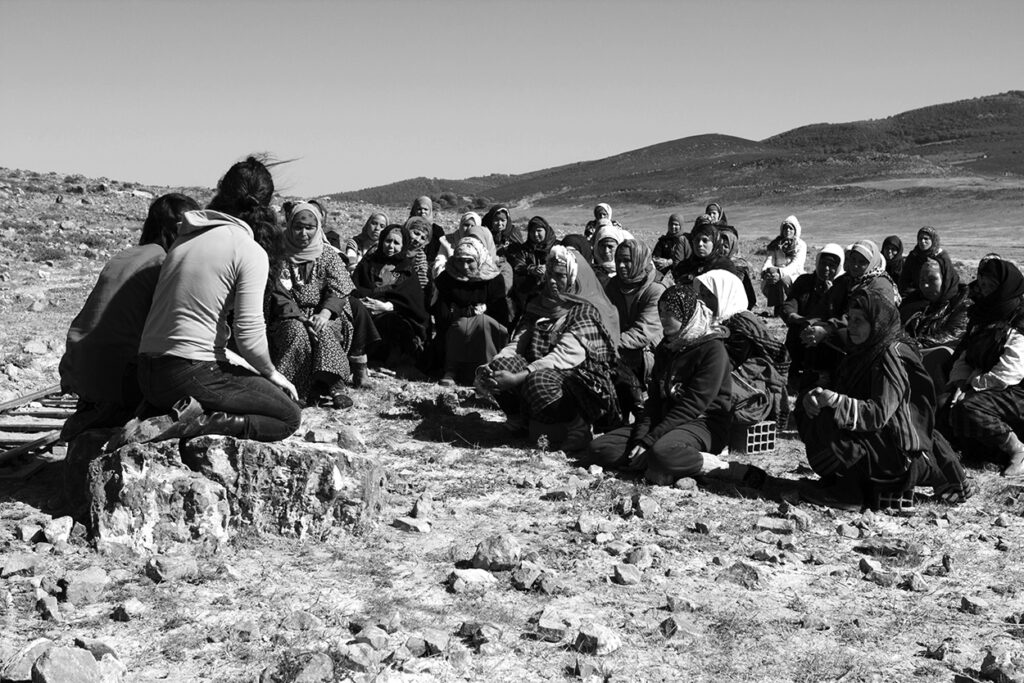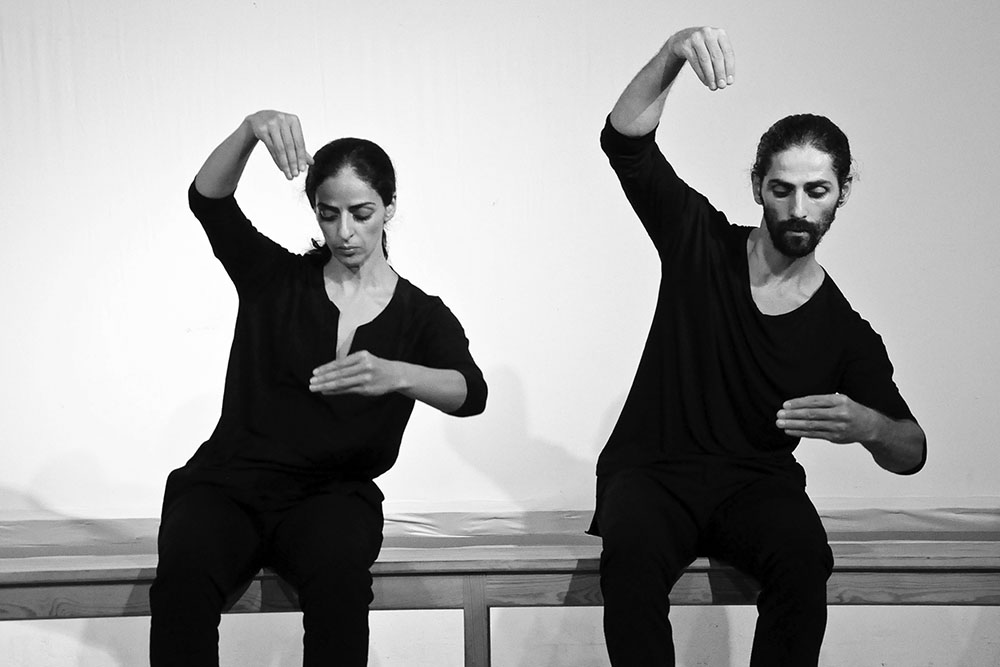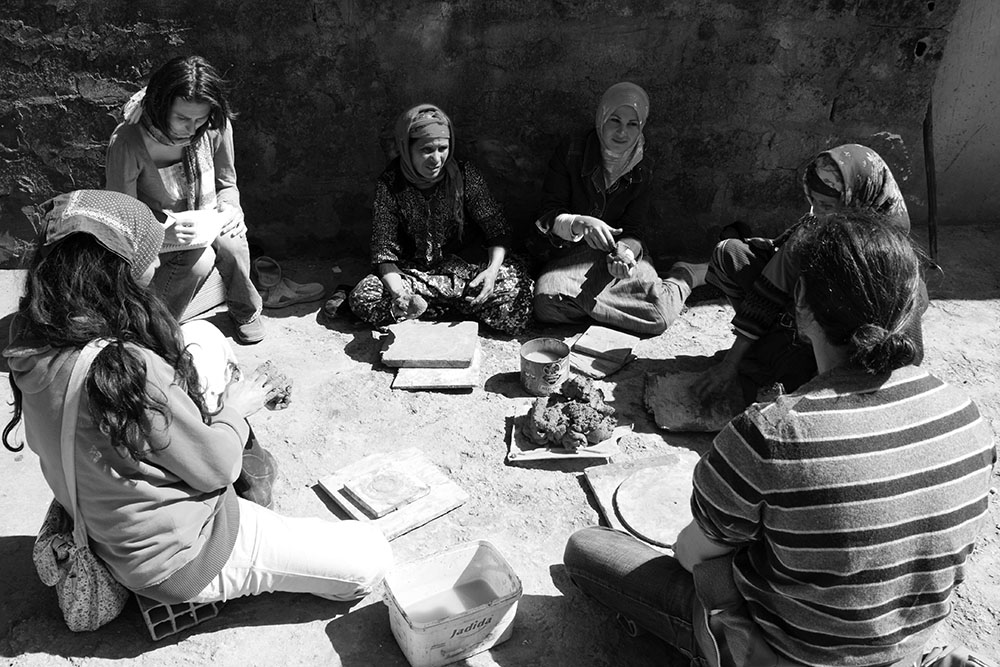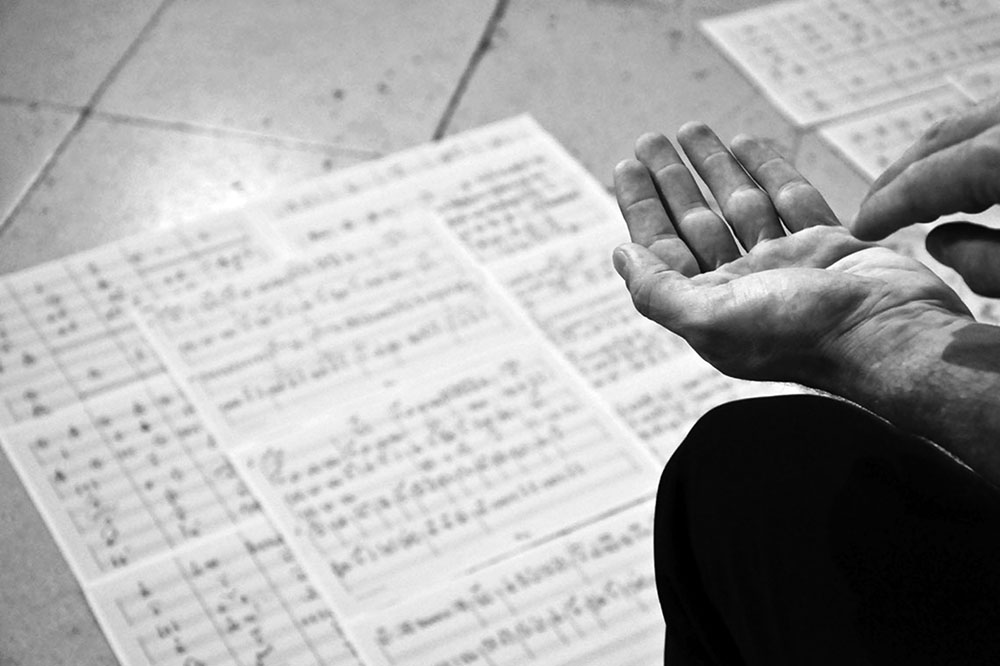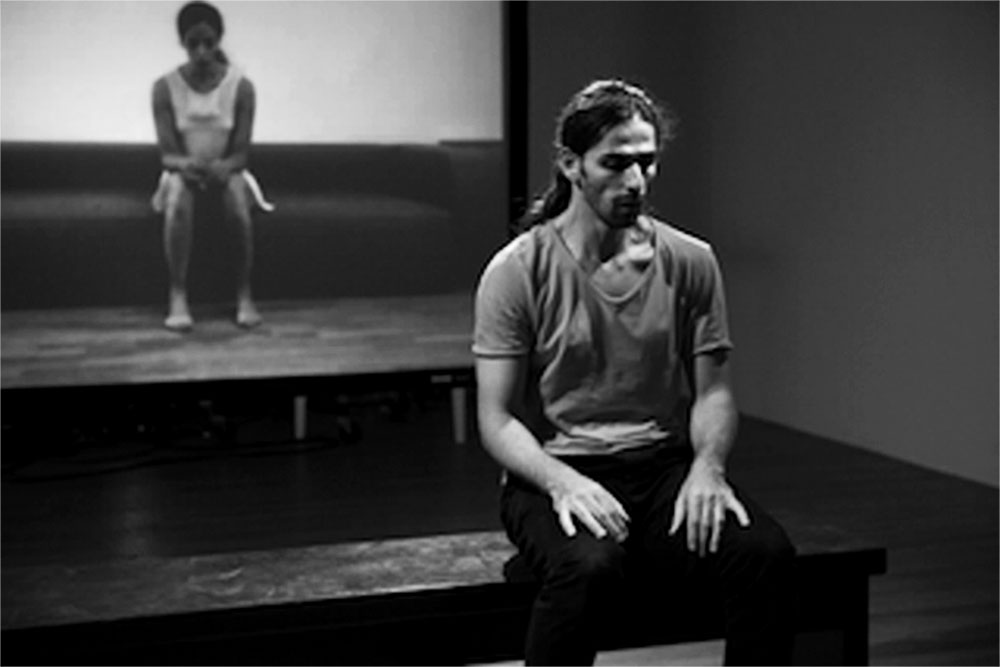Interview / Selma Ouissi / Version 3
We Think the World Through the Body
You founded Dream City in 2007. What can you tell us about this festival?
Dream City was originally conceived as a one-time artistic project. At the time, I was working with Sofiane in Europe, but we would regularly return to Tunis to work on different projects. During one of those visits, we gave an interview on a national TV station where we talked about our work. At a certain point in the live interview I said that the artists in this country were not being noticed at all and that it would be good to organize a peace march in a public square—to show the government how many artists actually live in Tunisia, and that it was time to start thinking seriously about cultural policy. Right then, the red lights in the studio went out. They cut the broadcast. The moderator, a very well-known journalist, was suspended, and her show was taken off the air.
I’m talking about the time of the dictatorship, it was 2006 and you couldn’t gather in large groups in public spaces. From that day on, we thought of a project where people would take to the streets for art. As choreographers, the idea of reclaiming space through the bodies of citizens felt natural to us.
We reached out to artists across all disciplines, but also to urban planners, sociologists, philosophers, and journalists. We were aware that we were also provoking a new kind of critical writing in Tunisia. Some of them joined us in forming a collective, L’Art Rue, and we invited artists to participate in the march. We decided on the route and chose the Medina of Tunis with its tangible and intangible heritage as the most suitable location. For nine months we worked week after week in secret, in Sofiane’s studio, and the artists thought about contextual works. From the beginning, it was clear this would be a march, a kind of parcours, where people would move from one piece to the next. There were performances, installations, videos, and more. The artists were accompanied and that was something new, because they were used to showing themselves in closed spaces, in theater or in galleries. They had never stepped out into the public or thought about making art for public space. And when I say public space, for me that means contextual art, insitu and outside the conventional frameworks. At the end, we all came together for a collective celebration. It was about contemporary art of high quality that could still be understood by everyone. It’s not enough to just have specialized knowledge—what matters is how you communicate it. That’s how Dream City was born. We only announced it two days before it happened, to avoid being shut down by the police. It took place on the national holiday, to celebrate the coup d’état on November 7. We planned it that way because it’s vacation time and the police are busy with the celebrations.
Still, Sofiane and I ended up at the police station—but by that point, so many people had already filled the streets. The first edition of Dream City lasted three days and drew 7,000 attendees. It was an incredible demonstration of politically engaged art. We really pushed the boundaries of artistic production. Every artist worked in the location they had chosen, and for us, it was a project about building connection and relationships.
When did you decide to repeat the project?
It was such a huge success. We returned to our work in Europe, but when we came back to Tunisia, people would stop us on the street asking when the next festival would happen. The artists told us they had come across something decisive for themselves in this project and for us it really was a work, an artistic act, an artistic manifestation, so … So, with the pressure and demand from people and artists who needed this kind of space, we kept going. For them, it felt like finally coming up for air, at a time when everyone felt drained. With Dream City, we’re trying to imagine how to bring art closer to the people. And as artists, we love that encounter.
How has life changed for artists in Tunisia since the Arab Spring?
Since the revolution, there have been many artists‘ collectives that use public space. They have realized how important this is and are committed to making art more accessible to people. The government has started paying more attention to the conditions artists face. There’s more awareness now and some small attempts to offer support—though it’s often underfunded and fragmented. There was a period when artists were being attacked by extremists, but that seems to have passed. Now we live in a society that technically has all the rights, even if it doesn’t always feel that way. Living that freedom isn’t always easy— if you decide as an artist to do something in public space, you may be attacked by the population because some people think it is forbidden.
In 2010, you and ten other artists started a collective with about 60 women potters from the Sejnane region. What kind of project was it, what were your goals and how did the collaboration with these women develop?
One day, I was walking through the streets of Paris after a meeting near the Ministry of Culture. I stopped in front of a gallery because I saw a doll from Sejnane in the window. I went in and asked for the price. I don’t remember the exact number, but it was at least 200 times more than what the women make when they sell the dolls by the roadside—for barely 10 euros. I left the gallery immediately and called Sofiane. I felt like the ground had shifted under my feet. My only question was: How does wealth distribution actually work today? That’s how the project began.
Neither of us had ever been to Sejnane before—it’s about two hours northwest of Tunis—and I would’ve never gone if I hadn’t come across that doll. The women work from home, often far from one another, and pottery is just one part of their day. They do the dishes, fetch water, wash clothes, and make pottery to earn money. It’s a long-standing tradition passed down by the Berbers who once traveled through that region. The symbols they paint on the dolls are Berber symbols. It’s a practice handed down from mother to daughter. These dolls used to be part of a bride’s trousseau—she carried a doll with her as a symbol of fertility. There are many layers of meaning. But we realized the women were isolated—they didn’t even know each other.
We started by asking what they needed as artists, and what they wished for most. Every single one said: more time. They mostly work at night. Because they’re isolated, it’s easy for someone to buy a doll from them and resell it for 250 euros. But if they came together, they could create a sustainable economic model. But we also realized how difficult this would be. They needed time, the feeling of being less isolated and not having the children around them all the time so that they could concentrate on their artistic work.
A children’s group had to be set up, with artistic methods and training for the women in childcare. We established a procedure, starting with getting to know each other, inviting other artists to follow us and bring other practices, and setting up a horizontal structure based on exchange. We would introduce them to our practices—dance and movement workshops, photo sessions, singing lessons—and they, in turn, would share their own art with us.
On the first day, each woman was supposed to choose a task she actually wanted to do. Two women spent the whole day making tea. Some took care of the children, and others cooked for everyone. Each chose her own role and, in doing so, found her place in this community—we began to live together. There were artists and volunteers who came to give some of their time. The whole process lasted until 2013. Words are not enough to describe what we have shared and gained from this experience. Bit by bit, the project evolved. Toward the end, we invited a ceramicist from Aubagne as part of Marseille-Provence 2013, along with a kiln expert, to help improve their technique.
You have to know that it is a very complex process to make these dolls. They have to gather wild pistachio from the mountains, collect clay from the other side of the range, fetch water, and so on. There’s so much work involved just to get the clay ready. And in the end, it’s much easier to get together and share the work.
Did they actually use this experience to get organized?
Some of them stayed. They now process orders together—something they’d never done before. Before, they were afraid one might steal another’s technique, but now they’ve realized life gets easier when you organize yourselves. They’re getting lots of orders from Tunisia and abroad. There’s a real media buzz around them, and public institutions have started to realize that this knowledge needs at least to be classified—maybe an NGO could take over our rather utopian project and turn it into something more sustainable with real funding structures.
The first phase was to end after six months with an exhibition to which journalists, NGOs and people from the ministry in Tunis were invited. We organized three buses to bring them from Tunis to Sejnane—not the other way around. The celebration was planned open air, and the idea was that we—all of us, the artists and the women—would each create a piece for the collective. So Sofiane and I worked on the gestures of three generations of women potters: a grandmother, the oldest still-practicing potter there; her daughter; and her granddaughter.
We thought about how we could recontextualize these gestures for the stage— We couldn’t go traveling with 60 women. Because at the beginning we had the idea that they should perform live, but when we tried it out, it turned out that it didn’t work even with the younger ones among them. They need to feel the earth in their hands—abstract gestures just don’t come naturally to them. That’s when we realized how far apart performance and practical work really are. So the two of us did it. We have composed an entire work of gestures, written with the symbols they use. It’s like a score made with the signs of Sejnane. For Laaroussa, we came up with 365 symbols. Since all the women are illiterate, we wanted to write the score in the language they actually use—the same symbols they use to sign their pottery or “write” on it. We found many signs that closely match their gestures. Sometimes we display a brochure showing a photo of the gesture with the corresponding symbol. We developed a whole vocabulary to compose this choreographic piece. During the performance, we sit the whole time, from beginning to end. There’s also a documentary film about the work. We wrote our own script for it. Our choreography was always in resonance with what is happening in the film.
When did you decide to start developing your own projects and choreographies—projects in public spaces and the videos often shown in the context of visual art? What motivated you to move in that direction?
We always went to Tunis to write our choreographies. That was really important for us, because it kept us deeply connected to Tunis. On the one hand, it allowed us to give something back to the people there, and on the other, it was essential for our own development to be in Tunis.
We gave workshops there and started presenting our pieces publicly right away. We visited music conservatories and the university of music and theater to share our choreographic material and develop it together with the students. In doing so, they got to meet the set designer and other professionals that Sofiane had already met in Belgium—people who have since continued working with us, which we’re very grateful for. They too generously contributed to the students’ training in Tunis. We always had this desire to share, because we were fully aware of how important it was for us to have had the chance to pursue this career in Europe, and to be able to come to France—because normally that’s not possible for young Tunisians, unless they come from wealthy families.
Today I think it is important for our artistic practice to develop such projects, projects that are an artistic act in themselves. The path to that is the path of sharing, exchanging with others, and working toward a society we dream of. That’s the treasure to be uncovered. This process is the actual artistic work. It’s true that programmers and museum curators have started to latch on. For them, the work is this or that video—but for us, that’s only the endpoint.
I find the way you work together via Skype really interesting …
Skype came into play when Sofiane decided to leave Michèle-Anne De Mey’s ensemble in Brussels and to return to Tunis. At that point, he no longer had the papers to stay or to re-enter—it’s very complicated. So we developed a method of working over Skype. At first, we didn’t even intend to turn it into a piece. It was just our way of continuing to work—him watching me, and me watching him—and in that way, we could analyze and write choreographic progressions.
In 2012 we were invited by Okwui Enwezor to the Triennale at the Palais de Tokyo, Sofiane was unable to travel and we wanted to describe exactly this situation. It corresponds to a state of emergency that affects many people. Enwezor was the first to present the performance Les Yeux d’Argos in London—that was something different. We worked that way for a long time, because I could only rarely travel to Tunis. We stopped dancing together in the studio, and eventually, that didn’t interest us anymore either.
People often think you’re twins. Your gestures and movements frequently feel like mirror images. Why is that?
It’s important to know that we really complement each other. I think we realized that when we were still very young. Sofiane has something that completes me, and vice versa. We don’t have the same strengths at all, but even people who work closely with us say we should do a piece about twins. That never interested us, because it’s a state of being. We are like that, it’s a bit like ying and yang and in the play Waçl, which deals with spirituality in the Fibonacci sequences, we are very aware of that. It is a study of the body through rotation, a whole piece consisting only of rotations. They’re not fast; this isn’t about whirling dervishes. We were searching for a method to keep moving infinitely while turning. During that time, it became especially clear to us how deeply we are connected. For example, I embrace the world by moving my arm forward across my stomach, while Sofiane does the exact same movement over his back—that says it all.
So it is not necessary to mirror him or vice versa, it is recognizable in the way we perceive space and it is inscribed in us. It’s the same when we compose for ourselves. It only works in that synchronization, that ambivalence—and we never wanted to point it out explicitly, because it’s simply part of who we are. We are aware of this, but we are not working on it.
We often say that we are not actually dancers or choreographers, I don’t know what we actually are, maybe we just think the world with our bodies, with a sensitivity for space and time. Working in a studio doesn’t really interest me anymore. When we worked on Waçl, we approached it in a very analytical way, and ever since we’ve been writing our own pieces, we’ve tried to formulate a “posture” or a positioning of our bodies in relation to the world for each one.
How do you write such a posture?
We are looking for combinations, simultaneously a choreographic motif and a specific posture that stands for a certain way of being in the world and in space. That’s really it. Our process is laborious, because we don’t come to it lightly or fall back on things we already know. I don’t want to perform a gesture just because I feel like it. We work a lot with video to find the right thing, we analyze our bodies and remain open to discoveries—like realizing that I take space from the front and he from the back. It would be much easier to work differently, but for us, no gesture is ever arbitrary. We always work with very precise motifs, and we stick with them until the end. We never go into the studio to improvise—that’s not the kind of dance we do. Each time we ask ourselves which body is the one that can transport the issue that concerns us, that preoccupies us and flows through us.
Last time you told me about your next project, about people telling their life stories through gestures.
It’s a commission from three contemporary institutions—the FRAC in Metz, the MSK in Ghent, and the Antoni Tàpies Foundation in Barcelona. After Laaroussa, they invited us to develop a follow-up project.
When we arrived in Metz, we started researching the city’s context and tried to understand what was going on locally. We were interested in the social and political issues. We visited a range of community organizations—there are many asylum seekers from the East, refugees from Syria, it’s a city with a large elderly population, and there are an unusually high number of institutions focused on sign language. We quickly realized that these groups are among the excluded and invisible in the city. So we decided to work with them.
We conducted video interviews with individuals, asking five difficult-to-answer questions—the same for everyone. Using these videos—without sound—we worked on the meaning of their gestures while they spoke about their lives and what deeply moves them. Afterward, we spent six months in workshops in Metz identifying which gestures stood out most for each person. I now ask myself whether we are really looking at each other closely and whether it is not the word, the discourse, that is causing problems these days?
After we left, the participants chose to continue the work. They hadn’t known each other before, and they came from many different countries. That’s when the idea of creating an artistic protocol emerged. It’s currently being implemented in Ghent and will be part of the final exhibition in Barcelona in May 2017. This protocol is a standalone piece. This protocol is a stand-alone work and we hired an illustrator in each city to capture the most prominent gestures of each person—30 gestures, to be exact. The project is designed to circulate from city to city—London and Brussels have already shown interest—and each city will receive its own protocol: a library of human gestures, filled with the gestures of all the people we meet.
